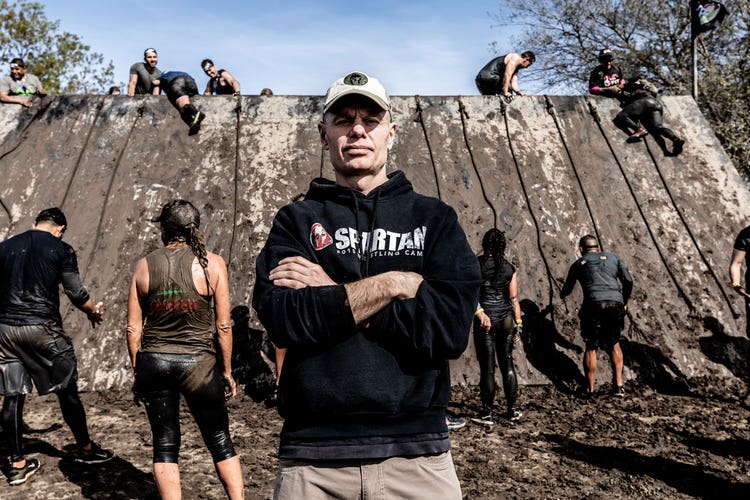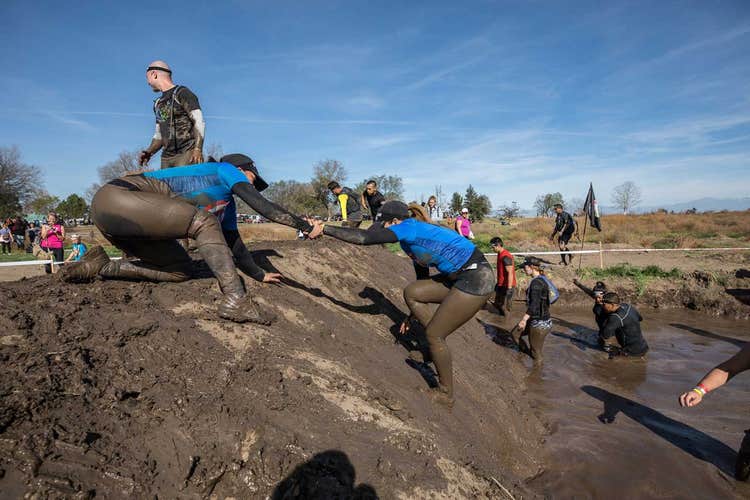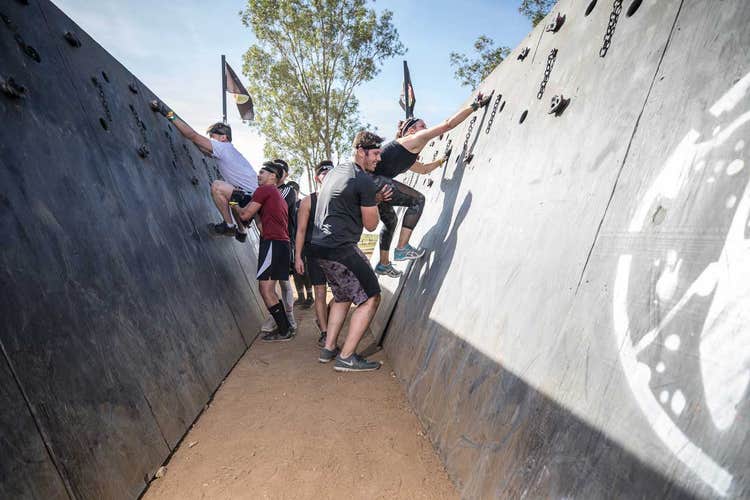Spartan: More Than a Race

Joe De Sena is standing at the end of the mud pit, stance wide, arms crossed, ball cap pulled down to shield his eyes from the piercing California sun. “Why are you WALKING? Come ON! This is a RACE! The finish line is closing in 12 MINUTES! You GOT IT! You’re AWESOME! RUN! RUN!” He’s shouting, cajoling, haranguing and laughing at Spartan Race participants slogging through waist-high, icy cold water.
The racers’ irritated half-smiles turn into full grins the instant they recognize who’s “coaching” them—the founder and CEO of Spartan. “JOE! Mr. De Sena! You changed my life! Can I take a picture with you?” A very fit young man stops for a selfie. A mother introduces her son. De Sena takes another selfie with a pregnant woman whose pink T-shirt is printed with a tiny bow and skull and crossbones on her baby bump.
The course is teeming with people you might not expect to see hustling and struggling together, stopping and dropping for burpees—and stopping to help one another. At the tire-flipping station, a man is coaching a stranger while our 24Life photographer starts yelling encouragement.

Who is the Spartan racer?
Although the course requires strength and skill, De Sena does not define Spartans by their athleticism. He says a Spartan is someone who’s willing to get out of his or her comfort zone: “They’re willing to push limits, take cold showers, go to bed early, wake up early and do all the things that our society somehow thinks is not normal [but that] human beings are supposed to do. We are animals, [and] animals are supposed to sweat and breathe heavy and run and do tough things.”
He starts teasing a couple of course monitors who drive by in an all-terrain vehicle. “What is this? They should be running. Somehow we’re getting soft.” They laugh, and one answers, “Yeah, what do we need helmets for?”
In all seriousness, De Sena says the Spartan mission is simple. “We want to introduce 100 million people to the person they should be and they could be,” he says. De Sena’s been stopped by grateful racers in airports, at sporting events in small towns in foreign countries, by people who are part of a community that “spans borders … different sizes and shapes; it’s gender-neutral; it’s 5 million unbreakable bonds.”

Motivation is the hardest part
Despite the rope climbing, wall scaling and burpees, De Sena says, “The top question we get asked in close to 40 countries is, ‘Joe, how do I get motivated?’”
De Sena is no stranger to feeling unmotivated. A sense of curiosity about his own physical capacity drove him in the early days, and now that he’s completed countless obstacle events, he relies on his personal commitment to do hard things (“as long as it’s safe and healthy”). At a recent Spartan event in Scotland, he spotted two 50-pound tent weights and thought, “You know, I would hate to carry those and do the course.” So he did the course hefting the weights in the pouring rain—with a bagpiper following him, for good measure.
But it doesn’t come down to just self-motivation, and community plays a significant role in a way that surprised De Sena. “The big thing I learned about myself is how much I love inspiring people,” he says. It’s also a massive responsibility. And, De Sena says to himself, “My God, who gets to do this? If I’m running in the rain and it’s dark, I get to do this.”

Personal board of directors
Participants in the Spartan events may come in all shapes and sizes and from all walks of life, but they have many of the same questions—about what to eat, how to train, how to tackle specific obstacles and how to stay the course. It seems natural to ask De Sena for the best advice he’s ever gotten. He replies, ‘“Everybody should have their own personal board of directors in life.’ For whatever reason, at a very young age, I was attracted to older people, and I quickly learned that older people who have made mistakes already in life are so willing to help.”
De Sena adds that they also expect action. “Think about how silly it is that people have made the mistakes already, learned from them and give us that wisdom, yet we don’t take it and decide to make these mistakes over and over for ourselves.”
As if on cue, at the end of the interview, De Sena spots a woman in mud-streaked purple leggings: “Marla! This is Marla, you have to meet her.” Marla Sweeney, 72, is from Tucson, Arizona, and says she started obstacle-course racing at 70 because she wanted to do something with her son (who’s 44) and grandson. She’s completed 23 obstacle course races in 24 months. De Sena jokes that she was kicking much younger racers out of the way on a 16-mile world championship course, and Sweeney agrees that she loves a challenge: the bucket carry, the barbed-wire crawl and the cargo nets.


“It’s family out there”
Asked what keeps her going, Sweeney says, “Well, I could stop any day and every day that I get up or before I go to bed. I have scoliosis. Right now, I have a slipped disk in my neck,” and she lists several other health issues—including a new one that’s potentially serious. “On some of the obstacles, I need help [due to osteoarthritis], but if I give into it, I’ll just lay around and be in pain. So I might as well get out and be active and feel better.”
Sweeney continues, “The Spartan Race is so different than any other sport because a lot of [people will] stop and help you. If they see you struggling or you’re going to fall, somebody right there—whether they know you or not—is going to stop and help you.”
With her perfect blond bob and purple manicure sparkling through the mud spatters, Sweeney is also sustaining that Spartan community. “There was a boy on the bus [to the event] today,” she says. “He was 18 and hadn’t done a Spartan before. I said, ‘It’s family out there. Ask for help if you need it.’ And even if you’re an elite or going for time, that’s what makes [an obstacle course race] special.”
Photos/video: Tom Casey, box24studio.com
Grooming: Tara Loren